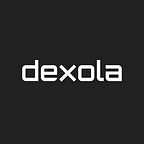Crypto Trends in 2024: Insights from Dexola’s CTO, Eugene Potemsky
As the tech chief and the founding figure of Dexola, Eugene Potemsky has been steering blockchain consultancy and software development enterprise for 8 years. Starting with a humble crew of ten, he has expanded the team to over 30 skilled coders who restlessly create solid solutions to enhance blockchain-related products and services. Eugene is also recognized as a driven entrepreneur, instrumental in securing a long-term partnership with the global digital powerhouse Trinetix Inc.
As a successful business owner and tech innovator, Eugene Potemsky has amassed extensive knowledge in both the CeFi/DeFi sectors and strategic management. This explains why his insights and predictions on the most promising initiatives in the blockchain industry for 2024 outlined in this write-up can be so valuable and utilitarian for Web3 leaders and inventors.
The year 2023 kicked off with an incredible opportunity: on January 1st, there was a chance to make a 100x return on BTC without facing liquidation. Now, as the year 2023 is over, we’re optimistic that this trend will persist!
Regardless of what the prices turn out to be next year, we’re committed to continuing our work. Web3 ecosystem is not about the prices, it is about the technologies with the potential to improve most of businesses. So let’s take a look at the trends that are likely to shape the crypto industry in 2024.
Balancing Regulation, Compliance, and Security
The recent bull run may have been triggered by BlackRock’s application for a spot Bitcoin ETF and developments in the FTX bankruptcy case. We’ve seen other institutions begin to actively use blockchain technology, not just explore it. For instance, JPMorgan has launched its JPM Coin for cross-border payments on its bespoke Onyx blockchain, while PayPal introduced PYUSD, accessible through its app. Additionally, more countries are delving into Central Bank Digital Currencies (CBDCs), an increasing number of companies are considering crypto investments, and Bitcoin futures volumes on the CME have surpassed those on Binance.
Institutions are eager to profit from crypto, but they seek to do so in a manner that is secure, legal, and reliable.
1. Regulation provides the assurance that every participant will be monitored by an authority and held accountable for any potential malicious acts or fraud. The incidents involving FTX, Terra, Celsius, and others have underscored the necessity for regulation to prevent the industry from remaining unregulated. Furthermore, these institutions aim to minimize the occurrence of pump-and-dump schemes and various forms of price manipulation, which are currently all too common. A good example to illustrate this is the price chart of Tellor (TRB).
2. Compliance means that institutions can access tools for working with crypto more easily, cutting through excessive bureaucracy and high fees. The proposed Bitcoin spot ETF would enable funds to gain exposure to Bitcoin through their regular stock exchanges, all while paying less than 1% annually in management fees.
3. While the matters of regulation and compliance rest squarely with local lawmakers, security is entirely the responsibility of users. Since 2017, hackers have stolen over $7 billion, with a significant portion ending up in North Korea. As Web3 developers, we need to focus on enhancing security to minimize such attacks and safeguard decentralized finance. This involves creating standard security checklists, advocating for security audits, and sharing our expertise to bolster overall security.
The Rising Tide of Ethereum L2s
Ethereum theoretically maxes out at 120 transactions per second, assuming it’s handling only ETH transfers with base fees. However, in reality, it processes about 12–15 TPS, a figure that pales in comparison to the thousands of transactions managed by VISA or Mastercard every second.
Many emerging protocols, capable of executing transactions in parallel, have the potential to surpass centralized networks in performance. Yet, they share a common shortcoming: limited liquidity. Ethereum continues to be the most liquid Layer 1 (L1) chain, making it the preferred choice for most DeFi innovation projects, either on its native platform or on Ethereum’s Layer 2 solutions (L2s).
L2s address Ethereum’s scalability issues and high transaction fees with some clever methods: they shorten block creation times, batch transactions, and utilize separate layers for data availability. The ease of bridging and compatibility with the Ethereum Virtual Machine (EVM) facilitates the transfer of liquidity from Ethereum to L2s. By January 2024, popular L2 chains had amassed over $10 billion in total value locked, a substantial amount to kickstart a distinct DeFi ecosystem.
Looking into 2024, we can expect to see further growth in L2 liquidity as various projects or institutions develop chains specifically tailored to their products.
The Second Wave of Anonymous L1s and L2s
The increasing clarity of blockchain’s pseudo-anonymity is becoming apparent, as most centralized exchanges have implemented Know Your Customer (KYC) protocols, many DeFi and NFT platforms now offer the option to link social media accounts, and the Ethereum Name Service has gained popularity.
Furthermore, advanced transaction monitoring tools, like the Crystal blockchain service, enable law enforcement agencies to identify almost any individual in Europe, the USA, Asia, or Australia who uses crypto regularly. Contrary to popular belief among many crypto users, DeFi and non-custodial wallets are not immune to tracking. RPC node providers may be legally required to collect and share personal data with authorities, and it was discovered that Ledger tracks the data of users on its Ledger Live application.
At Dexola, we anticipate that in 2024, as the push for global crypto regulation becomes more pronounced, there will be an uptick in the development of new, anonymizing networks that leverage zero-knowledge proofs or similar technologies. Given Ethereum’s critical role in the crypto ecosystem, these innovations might predominantly be zk-rollups or other zk-based Layer 2 solutions.
